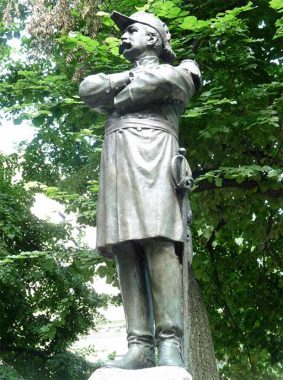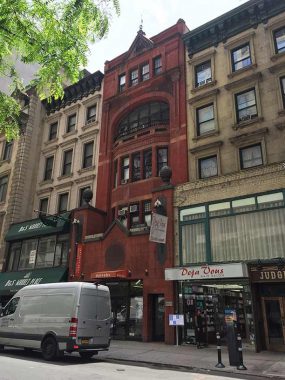
YOU can find connections in NYC in places that are miles apart. Take #36 West 56th Street, a Queen Anne -style mansion built in 1882 by architect Bruce Price for Dr. William J. Morton, one of the world’s first X-ray experts, in an era when this part of Manhattan was suburban, almost pastoral; now it’s heavily commercialized, with some of the tallest buildings in human history built nearby. For several months in 2019, I worked at a small design firm in the “MONY MONY” Mutual of New York building, 1740 Broadway at West 54th, whose sign inspired Richie Cordell and Tommy James to write and record “Mony Mony.” At lunch hour, I’d walk around and aim the camera around, and I was amazed to find pockets of 1880 amid all the 2010s architecture.

From here, let’s go almost 70 blocks uptown, to Sakura Park. While Grant’s Tomb and Riverside Church get all the tourist attention along Riverside Dr. at W. 122nd Street, this small park featuring cherry trees reflects a friendship the USA had with the nation of Japan early in the 20th Century that was severed by the attack on Pearl Harbor in 1941, but resumed after World War II. “Sakura” means “cherry blossom” in Japanese, and the Committee of Japanese Residents in New York was planning to import 2000 cherry trees to give to the city in 1909 as part of the Hudson-Fulton Celebration, which is little-remembered today, but was a large citywide celebration held from September 25th to October 9th that year on what was the 300th anniversary of Henry Hudson’s arrival in New York harbor and the 100th anniversary of Robert Fulton’s demonstration of the practicality of the steamboat; numerous parades and public celebrations were held, among them what was to be called the Parade of Ships on the Hudson River.
Tragedy occurred with that first shipment of cherry blossoms, which was lost at sea; a new shipment was brought in 1912, and many of the present cherry trees in Sakura and Riverside Parks descend from that original planting.

Among Sakura Park’s highlights are a stone Japanese tori, toro, or lantern, a gift to the park by the City of Tokyo in 1960 and a common element in many Japanese gardens.
Somewhat incompatibly in the otherwise Japanese-themed park is the presence of Gutzon Borglum’s statue of Major General Daniel Butterfield (1830-1901) who distinguished himself with his service at Chancellorsville, VA and at Gettysburg, PA in 1863, where he was wounded. Butterfield is perhaps best remembered as the composer of the mournful “Taps.” Borglum went on the sculpt the massive Presidential likenesses at Mount Rushmore.
By 1890, Dr. Morton had moved out of 36 West 56th, and none other than General Butterfield and his family moved in. Tragedy struck again. Fire can come literally out of nowhere. My dryer caught fire last week and I had never used it or turned it on, but it was plugged in, and a power surge or even a mouse chewing the wires set it afire. (We don’t know yet.).
A stove caught fire during Butterfield’s residency in 1890 and they wound up selling the place to widow Annie Barnes Kellogg, no relation to the cereal family. During Prohibition, 36 West 56th Street was home to a prominent speakeasy, the Mona Lisa Club. Currently the ground floor features Dainobu, a Japanese imported goods shop.
I feel a 56th Street Crosstown page coming on, but I’ll have to wait till it’s a bit less windy.
As always, “comment…as you see fit.” I earn a small payment when you click on any ad on the site.
2/18/25
